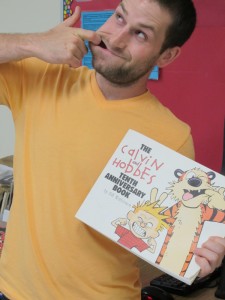Comics in the classroom
By Jennifer Martin

QUINTE WEST, ON. Bayside Secondary School teacher Kent Allin brings comics into the classroom. Photo by Jennifer Martin.
From reading Calvin and Hobbes as a kid to teaching graphic novels to kids in his high school English class. Who would have guessed that was possible?
Bayside Secondary School teacher, Kent Allin, did.
Allin said many people had told him that graphic novels had “no value” in the classroom, that their only purpose was entertainment. Always ready to delve deeper into things, he started to ask students what they thought and found out it was the opposite.
He started researching everything about starting a course that focused on graphic novels. He used little snippets of others’ curriculum while adding his own personal twist. Allin said he started the course three years ago and it has been a success.
He attributes the course’s popularity so far to the fact that, “it’s a variety, its anybody who likes the arts, anybody who likes the Englishes, anybody who has an interest in groups of media.”
Everyone has their niche and Allin’s course offers many of them. His course gives students the freedom to express what their interests are while they are still learning. Catherine Chokly went into the course expecting that it would be “mostly focused on the literary aspect of graphic literature.”
However that thought changed, “when Mr. Allin introduced artistic and design-oriented curriculum as well as the business side of making graphic novels.”
Allin has dealt with many stigmas, roadblocks and stereotypes. Most of those being the thought that comic books are not real books. He feels misunderstanding is the main reason why that thought occurs.
“In my world reading is reading. If you are going to tell your kid not to read, I really think that you’re missing the mark on it.”
It appears as though the interest for graphic novels in this area rests alone at Bayside Secondary School.
“I don’t think that there are many teachers, or even people my age, reading this stuff. I don’t think there are many people comfortable with it…” he said.
Bayside Secondary School’s administration has also been very supportive of the course, making it easier for Allin to deal with misunderstandings.
While his course has been quite popular since its start up three years ago, Allin believes at sometime it will not be. It would give him time to re-evaluate is curriculum, make more connections and push even harder to get the course well known. It would give him time to “step back and reflect on it, because I haven’t had time.”
His course has even inspired a few students to break out into something new and to consider possible careers in the sector, like a book artist. Allin feels that if he is able to connect with more people in that circle and introduce them to students, they will see that it is a viable field.
One of those students is Catherine Chokly. “Being an art student who is interested in graphic literature, I most certainly consider this field to be interesting and a possible career choice. However it is very demanding and a lot of work,” said Chokly.
She said she had a “fantastic” experience in Allin’s course because “he taught both the artistic and literary sides to graphic literature in an interesting and academic setting.” She attributes “his interesting perspectives on people and society in literature bringing a new twist to the stories held within the comics” as one of the most important things only Kent Allin could bring to a course such as this.
By bringing his love of comics and of society-based literature together in the graphic literature course, Allin has succeeded in making it “much more of a pleasure to learn”.
 Print This Post
Print This Post






